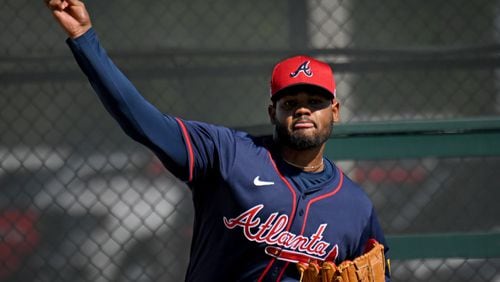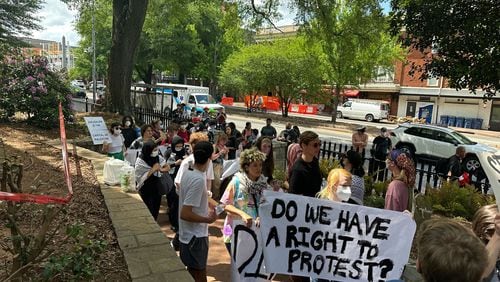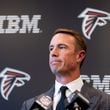NORTH PORT, Fla. – On March 2 in Dunedin, Reynaldo Lopez averaged 95.7 mph with his four-seam fastball and even hit 97.1 mph.
On March 12 in Bradenton, though, he topped out at 95.7 mph. He averaged 94.2 mph.
This is only spring training, but this slight velocity dip stood out because Lopez, a reliever for the past few seasons, is stretching out as a starter in camp. This transition, of course, comes with questions.
One of them: Where will his velocity sit? As a reliever, he had an upper-90s fastball that hit triple digits. But starters must pace themselves because they’re pitching more than an inning.
Lopez on Sunday allowed two runs – both on solo home runs – over five innings. He gave up four hits, walked a batter and struck out four.
He topped out at 96 mph.
Is this where he’ll be as a starter, or could the velocity tick up to, say, 97-98 mph?
“Yeah, I think so,” Lopez said through interpreter Franco García about increasing his velocity. “I think as the body keeps adapting to (being a starter and throwing more pitches), I feel like the ticks in velocity would continue to go up as well. It’s been three years since I’ve been a starter, so I think it takes a little while for the body to catch up and to get accustomed to the differences and the toll it takes on the body. Obviously, it’s different to go out there and throw five innings as opposed to just throwing a bullpen (session) or throwing an inning, or something like that. Yeah, I think it’s just the process and the evolution of transitioning back into a starting role.”
Through 16 2/3 innings this spring, Lopez has a 2.16 ERA. He hasn’t surrendered more than two runs in an outing.
Has he shown the Braves enough to make them believe he’d be good in the rotation to open the season?
“I think he’d be fine, yeah,” manager Brian Snitker said. “Like I say, we’re gonna sit down and evaluate this thing and see. You gotta start somewhere. Once you start and get the thing off the ground, anything can happen. As we’ve seen, stuff could happen in the first, second series. We’ll just kind of sit down, look at the options and what makes our club the best.”
Back to the velocity.
The Atlanta Journal-Constitution tracked almost all of the four-seam fastballs Lopez threw on Sunday. The breakdown on velocity – numbers are in miles per hour – for his day. The readings came from the CoolToday Park radar gun, which is shown on the scoreboard.
First inning: 92, 92, 94, 95, 94, 95, 95, 94, 94, 95
Second inning: 93 (home run pitch), 94, 94, 94, 96, 95, 95
Third inning: 93, 93, 94, 95, 95, 95, 95
Fourth inning: 94, 93, 94, 94, 94 (home run pitch), 94, 96, 94, 93, 96
Fifth inning: 93, 95, 93, 95, 94, 94
A few quick observations:
- Lopez held his velocity throughout the outing. He hit 96 mph in the fourth inning, and 95 mph in the fifth inning. This is encouraging because he held the velocity, and the stuff, throughout.
- It seems Lopez would throw harder as innings progressed. This could be coincidental, but it certainly points to him finding his footing as a starter in that he can throw hard, but he’s not blowing it out to begin frames.
- Snitker said Lopez’s legs were heavy when the Braves tried to push him out to four innings recently, but that he felt great on Sunday. Lopez hadn’t gone four full innings before Sunday, when he completed five.
In any discussion about Lopez, we must remember this: He’s still transitioning to becoming a starter. This takes time.
“When you’re going out there from the bullpen and you’re thinking to yourself (that) you only have an inning to pitch, and so you’re not holding back with your fastball, you’re throwing 10 fastballs as hard as you can knowing that’s your only outing, as opposed to when you’re a starter, your mentality is different,” Lopez said. “You’re focusing more on getting the first hitter out and throwing first-pitch strikes, and things like that.”
In a previous interview with The AJC this spring, Lopez mentioned taking a reliever’s mentality and applying it to starting. This is a fine balance because, as previously mentioned, no starter can throw maximum effort for five to six innings.
“Yeah, I feel like it’s been extremely beneficial to take those learned experiences from the bullpen and apply them into the starter role,” Lopez said. “I wish I would’ve had the knowledge that I have now, from the bullpen, when I was pitching (as a starter) in ‘17 and ‘18, just because all the things that I’ve learned from the bullpen, as far as placing the importance on first-pitch strikes to hitters, getting the first hitter of the inning out.”
In the offseason, the Braves told Lopez they would build him up as a starter. To this point, it doesn’t seem like he’s done anything to lose the fifth-starter job – especially because his competition, Bryce Elder, has allowed 11 earned runs over 12 innings across four starts in spring games.
“Ultimately, the decision (on my role) is the team’s, and whatever they decide is fine with me,” Lopez said. “I’m happy with whatever role I get placed in. I think this is the right approach. I think it’s a lot easier to get stretched out as a starter and then if you move into the bullpen, move into the bullpen that way, as opposed to the opposite, where if you start in the bullpen and try to get stretched out later as a starter, I feel like that’s more challenging.”







